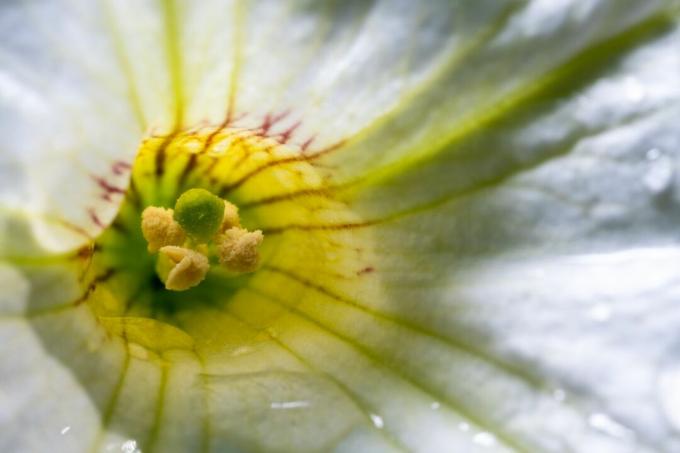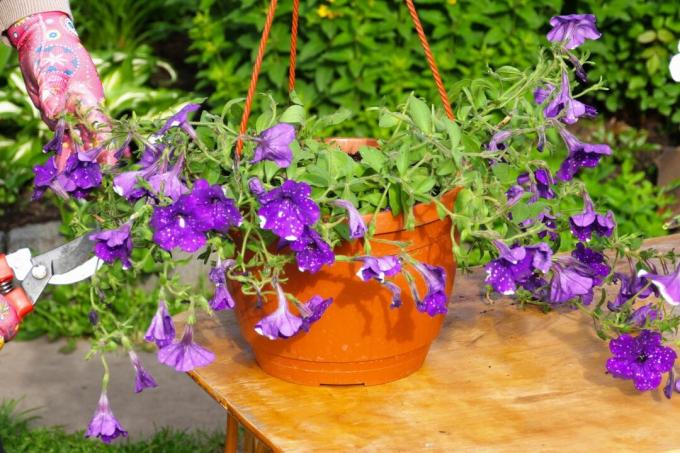Blooming petunias should not be missing in any summer garden. How to propagate petunias yourself from seeds or by cuttings can be found here.

Petunias (or with a botanical name Petunia) are annual plants of South American origin that unfortunately cannot withstand our frosty temperatures in winter. That is why you have to fill your balcony with fresh plants every year. However, these do not necessarily have to be bought expensively or laboriously overwintered. You can save a lot of money by simply propagating petunias yourself. This works via cuttings, which you can easily cut from the most beautiful plants in your possession, or via seeds. When propagating through seeds, new color variations can even come about when varieties of petunia are mixed with one another.
contents
-
Propagating petunias: sow seeds yourself
- Harvest seeds yourself
- Sowing the seeds
- Propagate petunias by cuttings
- Petunia varieties: a small selection
Propagating petunias: sow seeds yourself
Propagation by sowing works very well and is uncomplicated. The seeds can be bought in specialist shops. The variety selection is usually enormous here. If you already have petunias at home, you can harvest the seeds yourself. The salmon-colored “Salmon Wave” variety, for example, is particularly easy to grow from seeds and is even rainproof.
Harvest seeds yourself
You can easily harvest the seeds of petunias yourself. To do this, proceed as follows:
- Do not clean out withered inflorescences
- Harvest the seed pods when they are light brown and closed
- Dry the capsules in a warm, airy place until they burst
- Collect small, black seeds and store in a cool, dark place (e. B. Screw jar)
The formation of the seed pods starts all by itself as soon as you stop cleaning. The dried seed pods burst open after a few days.

Sowing the seeds
The seeds are sown from February. If you pay attention to a few points, you can be sure to enjoy small petunia seedlings soon.
- Fill the seed tray with germ-free seed compost
- Mix the seeds with dry quartz sand and distribute them evenly on the earth with sufficient space
- Seeds max. cover with a thin, permeable layer of soil (light germs)
- Germination temperature: min. 20 ° C
- Keep the soil evenly slightly moist with a water atomizer (water atomizer)
- Cover the seed tray with a foil hood (air once a day from germination)
- Bright location without direct sunlight
- From the 2nd Pair of leaves: prick out or transplant individually into small pots
- Acclimatize the plants outside before planting
- Transplant outside from mid-May (no more risk of frost)

Mixing with quartz sand is optional, but it considerably simplifies sowing the mini seeds. A thin layer of soil over the seeds will reduce the risk of mold growth. The foil hood provides the necessary humidity. The plants are acclimatized by putting them outside during the day on sunny days. You can find out which location is best for petunias from May in our article on the Growing petunias.
Tip: Although petunias theoretically bloom from June to the first frost, many plants are completely exhausted and wither prematurely because of their own pace in terms of blooming and growth. To avoid a flowering-free period, some of the seeds can be sown later (April / May).
Propagate petunias by cuttings
Hanging petunia varieties are particularly suitable for propagation via cuttings, as they can develop very long, strong shoots with the right care. If you do the following, it won't take long for your cuttings to form roots.
- It is best to cut cuttings in summer
- Use 10 cm long (preferably flowerless) shoots
- Remove all leaves and flowers (except the top pair of leaves)
- Place in a glass with lime-free water until roots have formed and then put in pots with soaked potting soil OR plant directly in the pots
- Propagation was successful when the cuttings sprout from above
- Repot into larger planters and continue cultivating like adult petunias
- Acclimatization of the cuttings before transplanting in mid-May

It can take two to three weeks for the cuttings to form sufficient roots in the jar of water. When planting directly in pots, the cuttings are simply inserted a few centimeters into the soil and then pressed down well. You can read all about the subsequent maintenance of your own small products here.
Petunia varieties: a small selection
There are varieties of petunia in abundance. The colors in which they bloom are just as varied. The flower shapes also vary. From simple to double flowers, there is something for every taste. The different varieties are traditionally divided into four groups of varieties.
- Miliflora with two to three centimeters large flowers
- Multiflora with about five centimeters large, rainproof flowers
- Floribunda with approx. eight centimeters large flowers
- Grandiflora with trumpet-like, rain-sensitive, very large flowers

Below is a list of particularly beautiful varieties of petunia.
- Night sky: The large flowers of this hanging petunia are reminiscent of a purple night sky, filled with white stars. One flower is never the same as another.
- Chocolina: This variety looks nice to bite into with its rather small, chocolate-colored flowers (please don't snack). It has a bushy, only slightly drooping habit.
- Pirouette Red: The Piroutte Red is a representative with double-filled flowers and a drooping habit. The red eye is surrounded by a beautiful white.
- Amore® Queen of Hearts: The name says it all: With red hearts on a yellow background, every single flower of the standing variety announces a message of love.
- Mirage Red Morn: This standing petunia makes every bed shine with its red-bordered flowers with a white eye.

Note: The most robust and easy to care for are the simple blue or purple petunias, e.g. B. the Big Time Blue variety. They even cope well with wind and rain. White flowering varieties tend to Chlorosis. The varieties "Yellow Apple Bee" and "Purple Balls" are very compact and even weatherproof.
Everything you need to know about Petunias - from cultivation to care to wintering - can be found in this article.
